CHEVROLET BLAZER 1996 2.G Owners Manual
Manufacturer: CHEVROLET, Model Year: 1996, Model line: BLAZER, Model: CHEVROLET BLAZER 1996 2.GPages: 392, PDF Size: 20.35 MB
Page 221 of 392
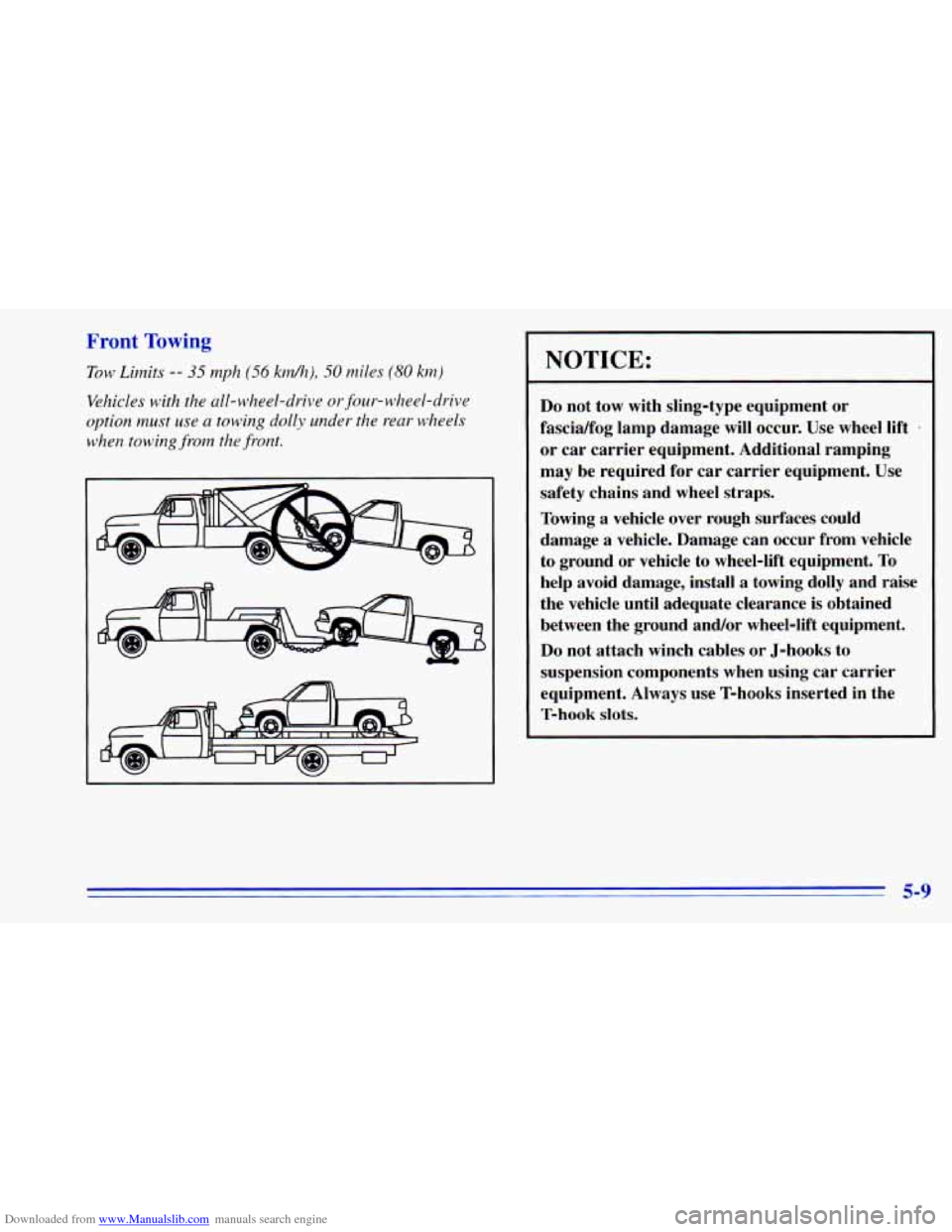
Downloaded from www.Manualslib.com manuals search engine Front Towing
Tow Limits -- 35 mph (56 kd?), 50 miles (80 kin)
Vehicles with the all-wheel-drive or four-wheel-drive
option must use
a towing dolly under the rear wheels
when towing
from the front.
I
NOTICE:
Do not tow with sling-type equipment or
fascia/fog lamp damage will occur, Use wheel lift
or car carrier equipment. Additional ramping
may be required for car carrier equipment. Use
safety chains and wheel straps.
Towing
a vehicle over rough surfaces could
damage
a vehicle. Damage can occur from vehicle
to ground or vehicle to wheel-lift equipment,
To
help avoid damage, install a towing dolly and raise
the vehicle until adequate clearance is obtained
between the ground and/or wheel-lift equipment.
Do not attach winch cables or J-hooks to
suspension components when using car carrier
equipment, Always use T-hooks inserted in the
T-hook
slots.
- 5-9
Page 222 of 392
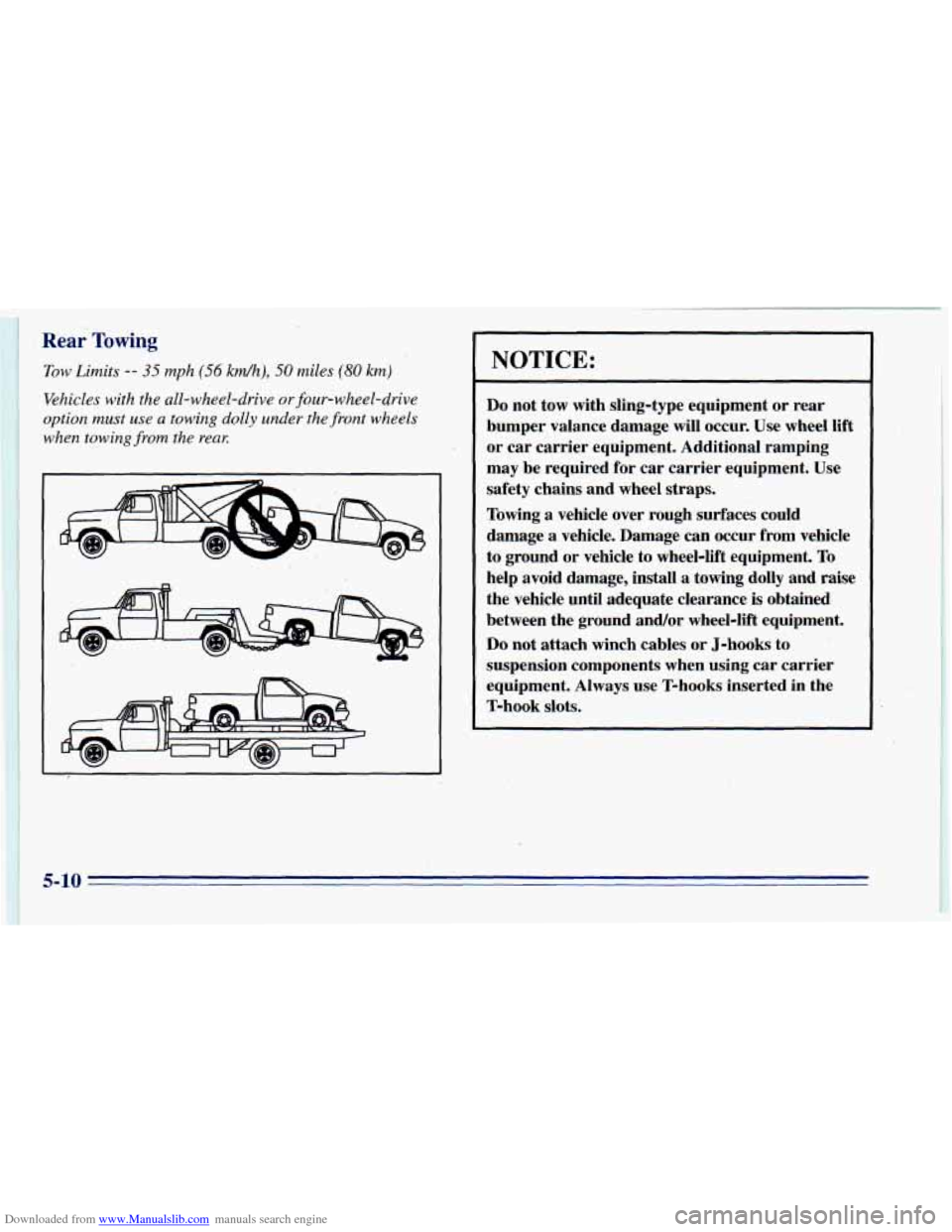
Downloaded from www.Manualslib.com manuals search engine Rear Towing
Tow Limits -- 35 mph (56 kh), 50 miles (80 km)
Vehicles with the all-wheel-drive or four- wheel-drive
option must use a towing dolly under the front
wheels
when towing from the real:
NOTICE:
Do not tow with sling-type equipment or rear
bumper valance damage will occur. Use wheel lift
or car carrier equipment. Additional ramping may be required for car carrier equipment. Use
safety chains and wheel straps.
Towing a vehicle over rough surfaces could
damage
a vehicle. Damage can occur from vehicle
to ground or vehicle to wheel-lift equipment. To
help avoid damage, install a towing dolly and raise
the vehicle until adequate clearance is obtained
between the ground and/or wheel-lift equipment.
Do not attach winch cables or J-hooks
to
suspension components when using car' carrier
equipment. Always use ,T-hooks inserted in the
T-hook slots.
Page 223 of 392
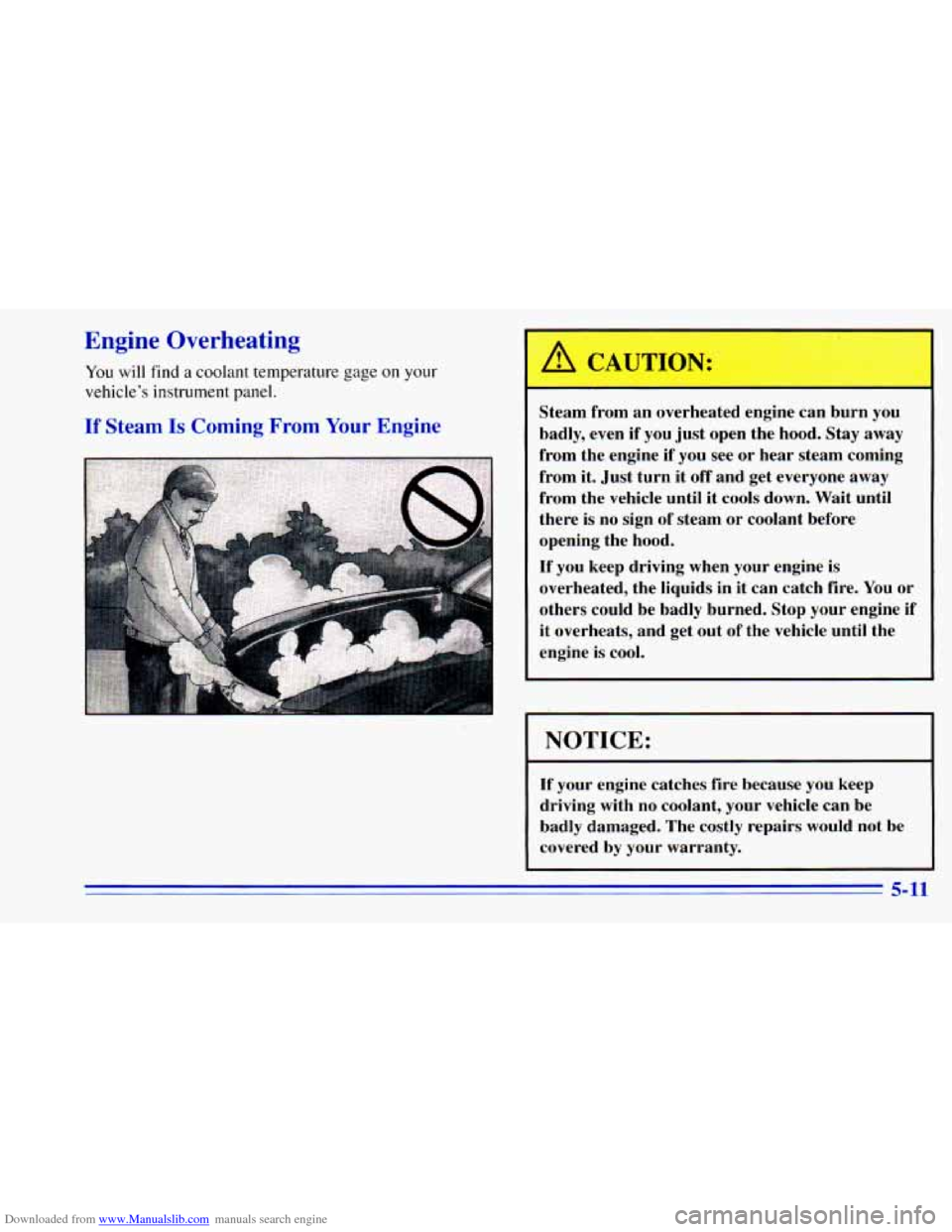
Downloaded from www.Manualslib.com manuals search engine Engine Overheating
You will find a coolant temperature gage on your
vehicle’s instrument panel.
If Steam Is Coming From Your Engine
- :/..:
Steam from an overheated engine can burn you
badly, even if you just open the hood. Stay away
from the engine if you see or hear steam coming
from it. Just turn it
off and get everyone away
from the vehicle until it cools down. Wait until
there
is no sign of steam or coolant before
opening the hood.
If you keep driving when your engine is
overheated, the liquids in it can catch fire.
You or
others could be badly burned. Stop your engine if
it overheats, and get out of the vehicle until the
engine is cool.
I NOTICE:
If your engine catches fire because you keep
driving with no coolant, your vehicle can be
badly damaged. The costly repairs would not be
covered
by your warranty.
5-11
Page 224 of 392
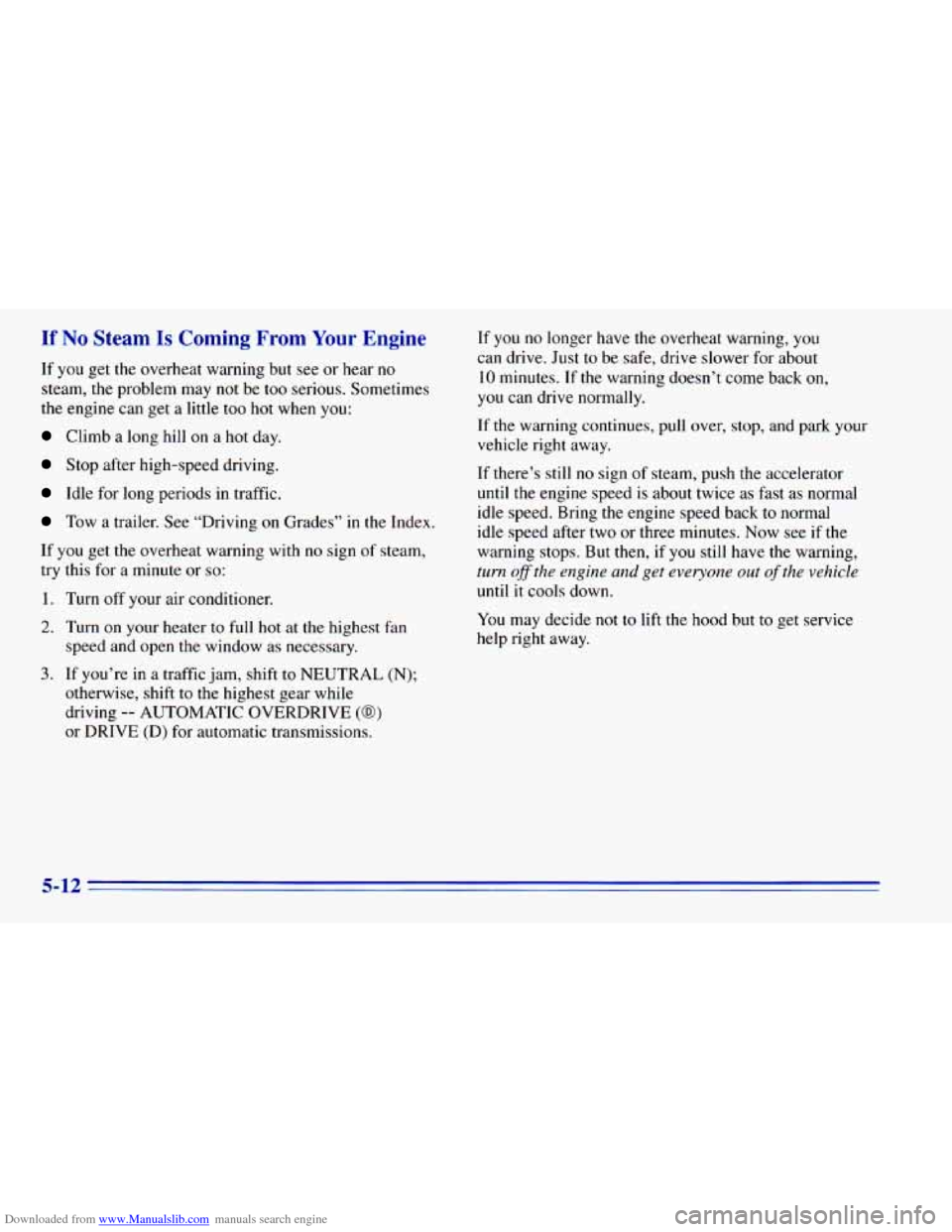
Downloaded from www.Manualslib.com manuals search engine If No Steam Is Coming From Your Engine
If you get the overheat warning but see or hear no
steam, the problem may not be too serious. Sometimes
the engine can get a little too hot when you:
Climb a long hill on a hot day.
Stop after high-speed driving.
Idle for long periods in traffic.
Tow a trailer. See “Driving on Grades” in the Index.
If
you get the overheat warning with no sign of steam,
try this for a minute or
so:
1. Turn off your air conditioner.
2. Turn on your heater to full hot at the highest fan
speed and open the window as necessary.
3. If you’re in a traffic jam, shift to NEUTRAL (N);
otherwise, shift to the highest gear while
driving
-- AUTOMATIC OVERDRIVE (@)
or DRIVE (D) for automatic transmissions. If
you no longer have the overheat warning, you
can drive.
Just to be safe, drive slower for about
10 minutes. If the warning doesn’t come back on,
you can drive normally.
If
the warning continues, pull over, stop, and park your
vehicle right away.
If there’s still
no sign of steam, push the accelerator
until the engine speed is about twice as fast as normal
idle speed. Bring
the engine speed back to normal
idle speed after two or three minutes. Now see if the
warning stops. But then, if you still have the warning,
turn ofthe engine and get everyone out of the vehicle
until it cools down.
You may decide not to
lift the hood but to get service
help right away.
5-12
Page 225 of 392
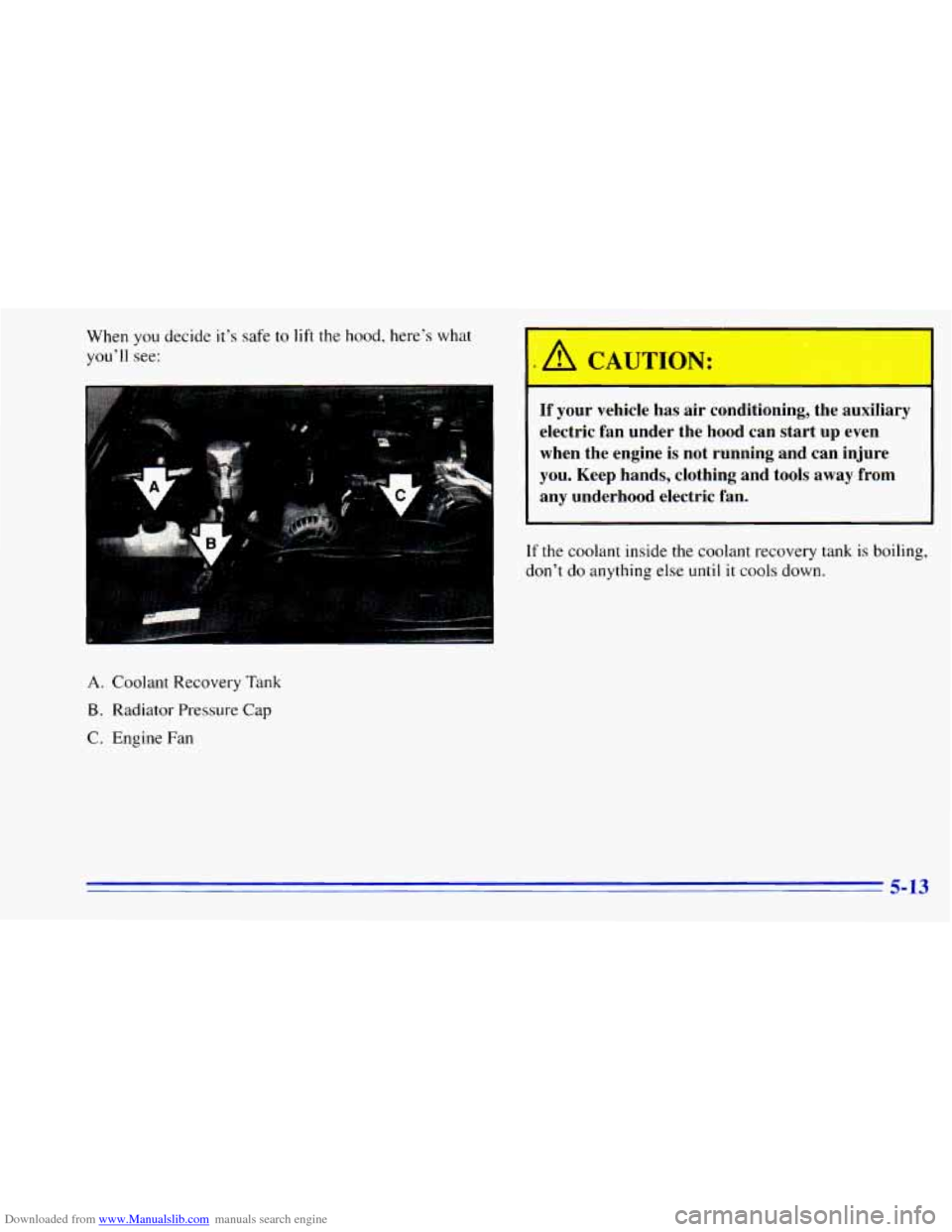
Downloaded from www.Manualslib.com manuals search engine When you decide it's safe to lift the hood, here's what
you'll see:
A. Coolant Recovery Tank
B. Radiator Pressure Cap
C. Engine Fan
If your vehicle has air conditioning, the auxiliary
electric fan under the hood can start up even
when the engine is not running and can injure
you. Keep hands, clothing and tools away from
any underhood electric fan.
If the coolant inside the coolant recovery tank is boiling,
don't
do anything else until it cools down.
5-13
Page 226 of 392
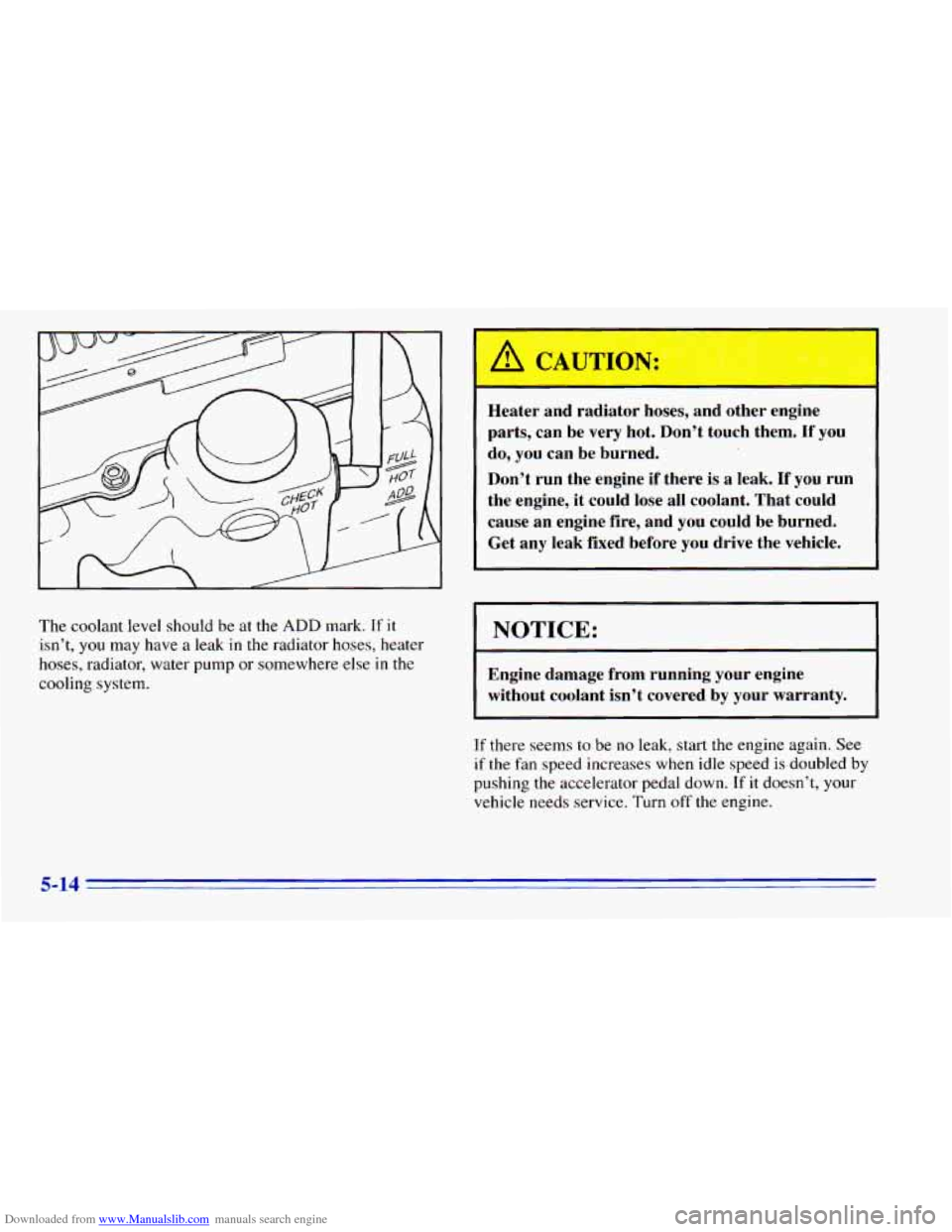
Downloaded from www.Manualslib.com manuals search engine L
The coolant level should be at the ADD mark. If it
isn't, you may have a leak in the radiator hoses, heater
hoses, radiator, water pump or somewhere else
in the
cooling system. Heater and radiator
hoses, and other engine
parts, can be very hot. Don't touch them. If you
do, you can be burned.
Don't run the engine if there is
a leak. If you run
the engine, it could lose all coolant, That could
cause an engine fire, and you could be burned.
Get any leak fixed before you drive the vehicle.
NOTICE:
Engine damage from running your engine
without coolant isn't covered by your warranty,
If there seems to be no leak, start the engine again. See
if
the fan speed increases when idle speed is doubled by
pushing the accelerator pedal down.
If it doesn't, your
vehicle needs service. Turn off the engine.
5-14
Page 227 of 392
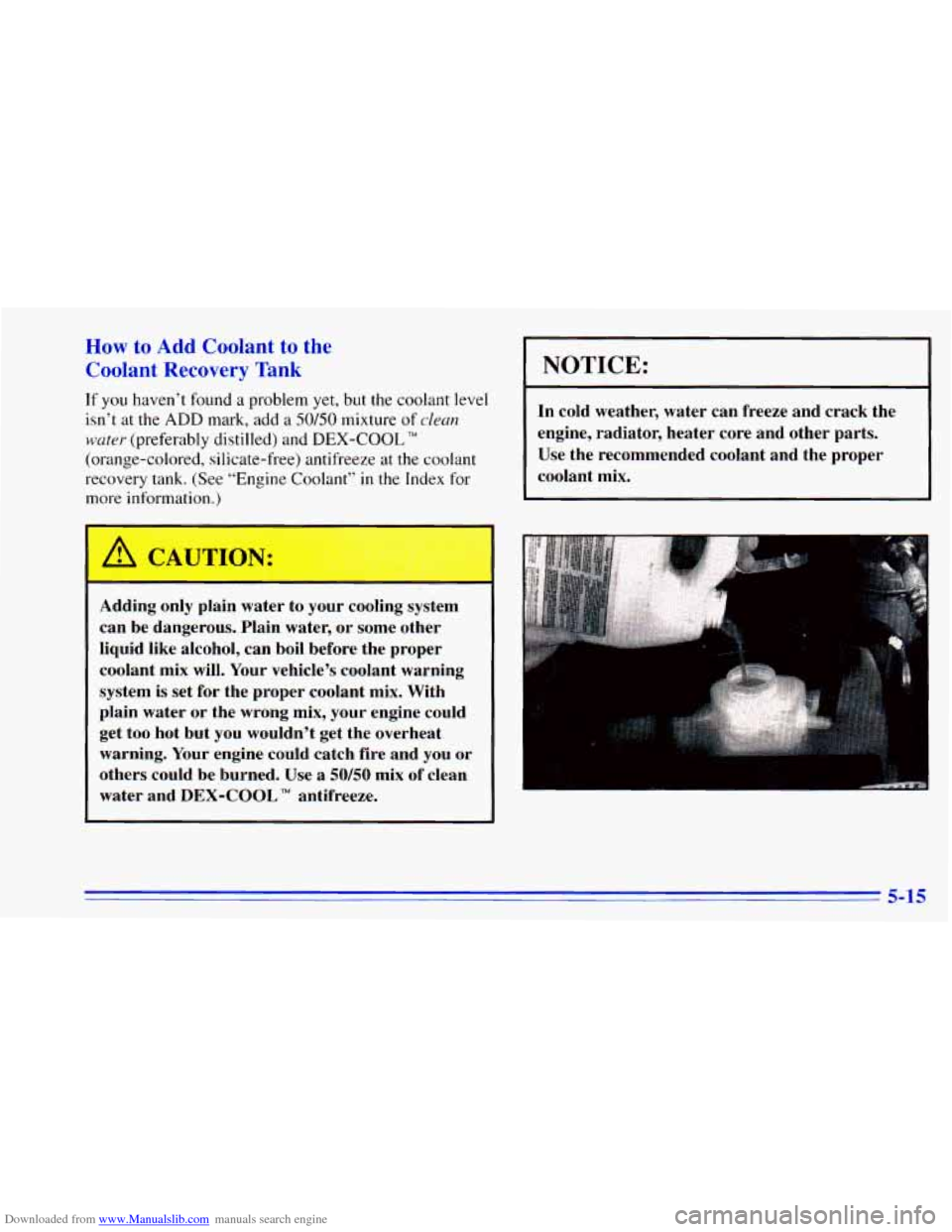
Downloaded from www.Manualslib.com manuals search engine How to Add Coolant to the
Coolant Recovery Tank
If you haven’t found a problem yet, but the coolant level
isn’t at the
ADD mark, add a 50/50 mixture of clean
water (preferably distilled) and DEX-COOL TM
(orange-colored, silicate-free) antifreeze at the coolant
recovery tank. (See “Engine Coolant”
in the Index for
more kformation
)
Adding only plain water to your cooling system
can be dangerous. Plain water, or some other
liquid like alcohol, can boil before the proper
coolant mix will. Your vehicle’s coolant warning
system is set for the proper coolant mix. With
plain water or the wrong mix, your engine could
get too hot but you wouldn’t get the overheat
warning. Your engine could catch fire and you or
others could be burned. Use
a 50/50 mix of clean
water and
DEX-COOL TM antifreeze.
1 NOTICE:
In cold weather, water can freeze and crack the
engine, radiator, heater core and other parts. Use the recommended coolant and the proper
coolant mix.
5-15
Page 228 of 392
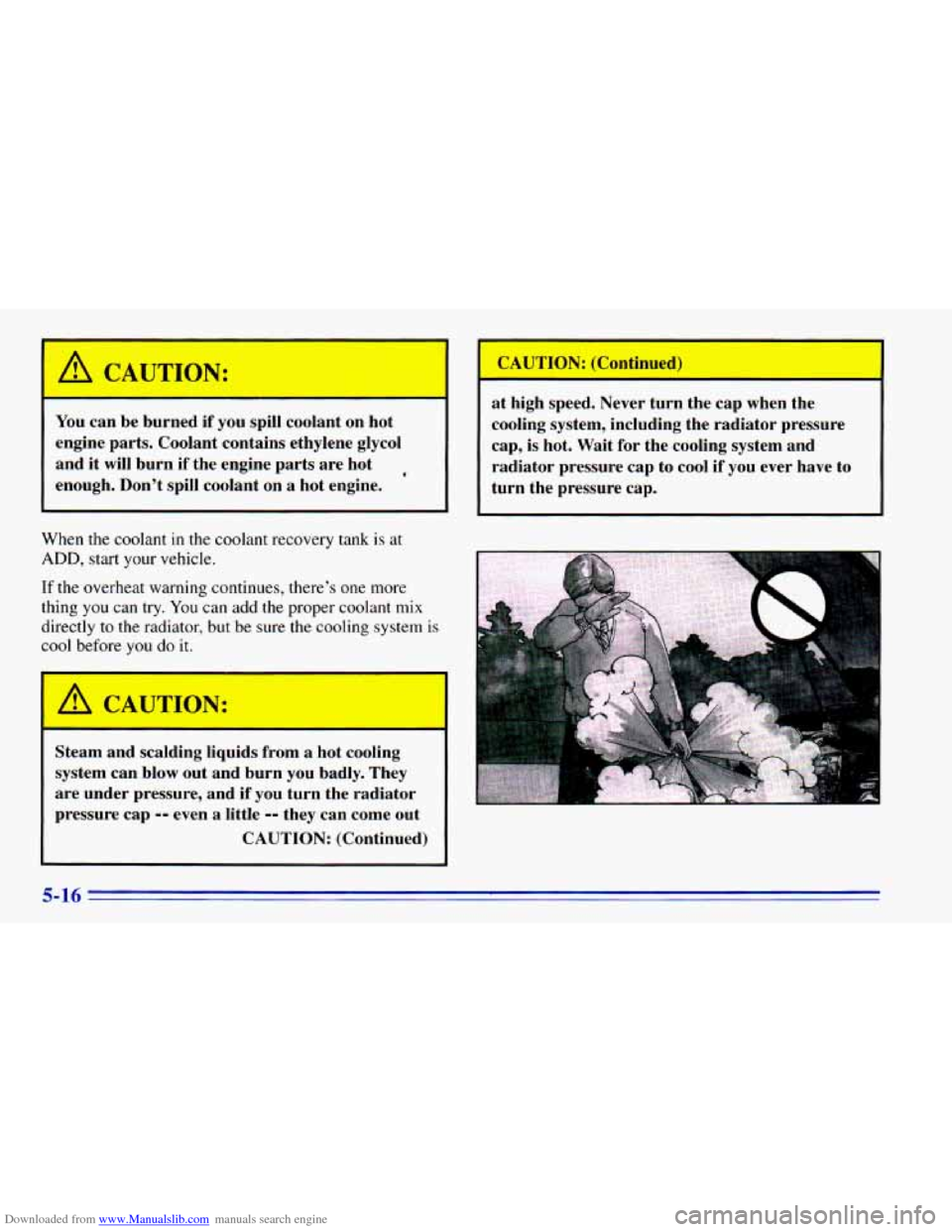
Downloaded from www.Manualslib.com manuals search engine I A CAUTION:
YOL -an be burned if you spill coolant on hot
engine parts. Coolant contains ethylene glycol
and it will
burn if the engine parts are hot
enough. Don’t spill coolant on
a hot engine.
*
When the coolant in the coolant recovery tank is at
ADD, start your vehicle.
If the overheat warning continues, there’s one more
thing
you can try. You can add the proper coolant mix
directly to the radiator, but be sure the cooling system is
cool before
you do it.
I A CAUTION:
t ~ am and scalding liqu--_J from a hot cooling
system can blow out and burn you badly. They
are under pressure, and if you turn the radiator
pressure cap
-- even a little -- they can come out
CAUTION: (Continued)
CAI JTTON: (Continued)
at high speed. Never turn the cap when the
cooling system, including the radiator pressure
cap, is hot. Wait for the cooling system and
radiator pressure cap to cool if you ever have to
turn the pressure cap.
E
5-16
Page 229 of 392

Downloaded from www.Manualslib.com manuals search engine How to Add Coolant to the Radiator
A
1. You can remove the radiator pressure cap when
the cooling system, including
the radiator pressure
cap and upper radiator hose, is
no longer hot. Turn
the pressure cap slowly counterclockwise until
it
first stops. (Don’t press down while turning the
pressure cap.)
If you hear a hiss, wait for that to stop. A hiss means
there
is still some pressure left.
2. Then keep turning the pressure cap, but now push
down
as you turn it. Remove the pressure cap.
5-17
Page 230 of 392

Downloaded from www.Manualslib.com manuals search engine 3. Fill the radiator with the proper mix, up to the base
of the filler neck.
4. Then fill the coolant recovery tank to the ADD mark.
5. Put the cap back on the coolant recovery tank, but
leave
the radiator pressure cap off.
5-18